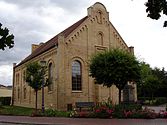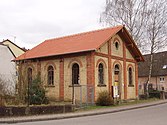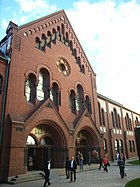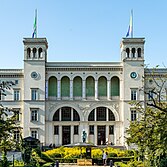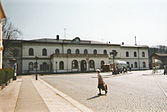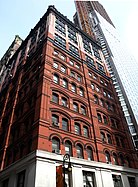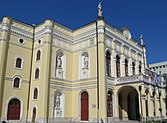
Gottfried Semper was a German architect, art critic, and professor of architecture who designed and built the Semper Opera House in Dresden between 1838 and 1841. In 1849 he took part in the May Uprising in Dresden and was put on the government's wanted list. He fled first to Zürich and later to London. He returned to Germany after the 1862 amnesty granted to the revolutionaries.
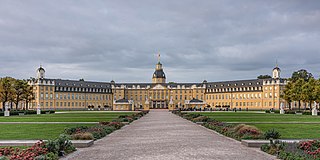
Karlsruhe is the third-largest city of the German state of Baden-Württemberg, after its capital Stuttgart and Mannheim, and the 22nd-largest city in the nation, with 308,436 inhabitants. It is also a former capital of Baden, a historic region named after Hohenbaden Castle in the city of Baden-Baden. Located on the right bank of the Rhine near the French border, between the Mannheim-Ludwigshafen conurbation to the north and Strasbourg to the south, Karlsruhe is Germany's legal center, being home to the Federal Constitutional Court, the Federal Court of Justice and the Public Prosecutor General.

Romanesque Revival is a style of building employed beginning in the mid-19th century inspired by the 11th- and 12th-century Romanesque architecture. Unlike the historic Romanesque style, Romanesque Revival buildings tended to feature more simplified arches and windows than their historic counterparts.

The Fasanenstrasse Synagogue was a liberal Jewish synagogue in Berlin, Germany opened on 26 August 1912. It was located in an affluent neighbourhood of Charlottenburg on Fasanenstrasse off Kurfürstendamm at numbers 79–80, close to the Berlin Stadtbahn and Zoo Station.

Moorish Revival or Neo-Moorish is one of the exotic revival architectural styles that were adopted by architects of Europe and the Americas in the wake of Romanticist Orientalism. It reached the height of its popularity after the mid-19th century, part of a widening vocabulary of articulated decorative ornament drawn from historical sources beyond familiar classical and Gothic modes. Neo-Moorish architecture drew on elements from classic Moorish architecture and, as a result, from the wider Islamic architecture.

Hersfeld Abbey was an important Benedictine imperial abbey in the town of Bad Hersfeld in Hesse, Germany, at the confluence of the rivers Geisa, Haune and Fulda. The ruins are now a medieval festival venue.

Heinrich Hübsch was a German architect. After studies in Heidelberg (1813–15) and at Friedrich Weinbrenner's school of architecture in Karlsruhe (1815–17) he traveled extensively in Greece and Italy (1817–24). In 1831 he was appointed Oberbaurat at Karlsruhe. He designed many churches and other public buildings, mainly in the Grand Duchy of Baden, and is also known for his writings.
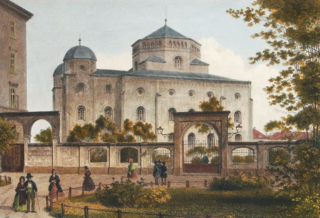
The Semper Synagogue, also known as the Dresden Synagogue, designed by Gottfried Semper and built from 1838 to 1840, was dedicated on 8 May 1840. It was an early example of the Moorish Revival style of synagogue architecture.
The Tempel Synagogue was a Jewish synagogue in Przemyśl, Poland.
Albrecht Rosengarten (1809–1893), was among the first Jewish Germans to be permitted to train and practice as an architect.

The Kassel Synagogue is the description given to a succession of prayer houses of the Jewish community in Kassel, Hesse.

The Church of St. Joseph of the Holy Family is a Black Catholic parish church of the Roman Catholic Archdiocese of New York, located at 401 West 125th Street at Morningside Avenue in the Harlem neighborhood of Manhattan, New York City. It is the oldest existing church in Harlem and above 44th Street in Manhattan. On June 28, 2016, it was designated a New York City Landmark.
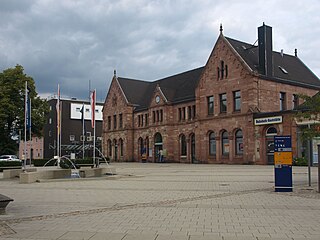
Bad Hersfeld station is a through station in Bad Hersfeld in the German state of Hesse on the Frankfurt–Göttingen railway. The first station was opened in 1866 and the current station building was completed in 1883. It is classified by Deutsche Bahn as a category 3 station. It is a stop for Intercity-Express and Intercity services and is a public transport node for northern Hesse.

The Mansion Hill Historic District encompasses a part of the Mansion Hill neighborhood northwest of the capitol square in Madison, Wisconsin. In the 19th century the district was home to much of Madison's upper class, and held the largest concentration of large, ornate residences in the city, but in the 20th century it shifted to student housing. In 1997 the district was added to the National Register of Historic Places.

The Carrie Pierce House is an elegant house built about 1857 in Madison, Wisconsin for Alexander McDonnell, one of the builders of the third Wisconsin state capitol. In 1972 the house was listed on the National Register of Historic Places

Alexander Saeltzer was a German-American architect active in New York City in the 1850s and 1860s. His work includes the Anshe Chesed Synagogue, Academy of Music, Theatre Francais, the Duncan, Sherman & Company building and the South Wing of the Romanesque revival structure at 425 Lafayette Street built between 1853 and 1881 as the Astor Library.

Romanesque Revival, Norman Revival or Neo-Norman styles of building in the United Kingdom were inspired by the Romanesque architecture of the 11th and 12th centuries AD.

Heinrich Ernst Gottfried Rudolf Wiegmann was a German painter, archaeologist, art historian, graphic artist and architect. He worked in the Classical style and, as a painter, is best known for his vedute. His wife, Marie Wiegmann, whom he married in 1841, was also a painter of some note.
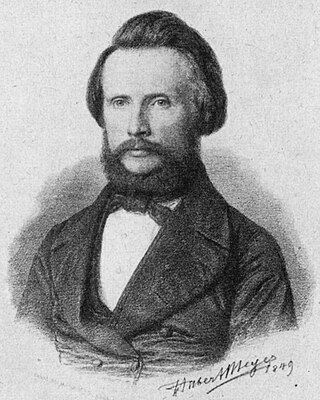
Jakob Friedrich Eisenlohr was a German architect and university professor. His design for a cuckoo clock, now known as the Bahnhäusle style, was the first to be mass-produced and helped make the clocks popular outside of Germany.













